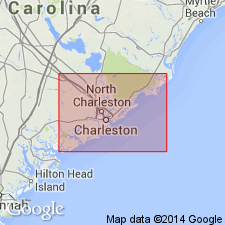
- Usage in publication:
-
- Givhans beds*
- Modifications:
-
- Informally named
- Dominant lithology:
-
- Limestone
- AAPG geologic province:
-
- Atlantic Coast basin
Summary:
Givhans beds, informally named in this report, are composed of fine- to medium-grained quartzose calcarenite. Aragonite absent, but molds and casts of aragonitic mollusk shells are present. Includes basal 2-cm-thick bed of black, rounded phosphate pebbles. Maximum thickness is 7 m. Unit identified in only a few outcrops and subsurface localities near Charleston, SC. Lithologically distinct from Raysor Formation, but cannot be separated from it temporally. Pliocene in age but older than Bear Bluff Formation and Goose Creek Limestone. Overlies Miocene Coosawhatchie Formation.
[Givhans beds = Goose Creek Limestone (stratotype) or "lower Goose Creek Limestone." Lie below Bear Bluff Formation (stratotype) and above Wabasso beds. Age is early Pliocene. See R.H. Willoughby and others, 1999, South Carolina Geol. Survey Gen. Geol. Chart, no. 1.]
Source: Modified from GNU records (USGS DDS-6; Reston GNULEX).
For more information, please contact Nancy Stamm, Geologic Names Committee Secretary.
Asterisk (*) indicates published by U.S. Geological Survey authors.
"No current usage" (†) implies that a name has been abandoned or has fallen into disuse. Former usage and, if known, replacement name given in parentheses ( ).
Slash (/) indicates name conflicts with nomenclatural guidelines (CSN, 1933; ACSN, 1961, 1970; NACSN, 1983, 2005, 2021). May be explained within brackets ([ ]).

